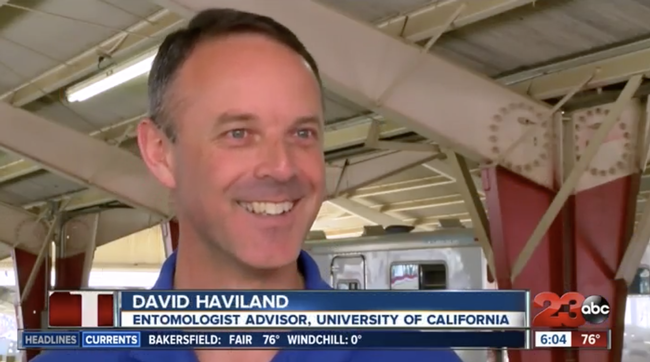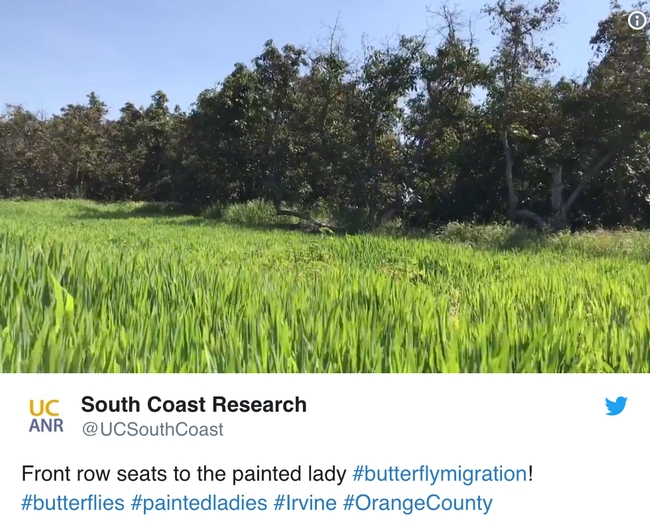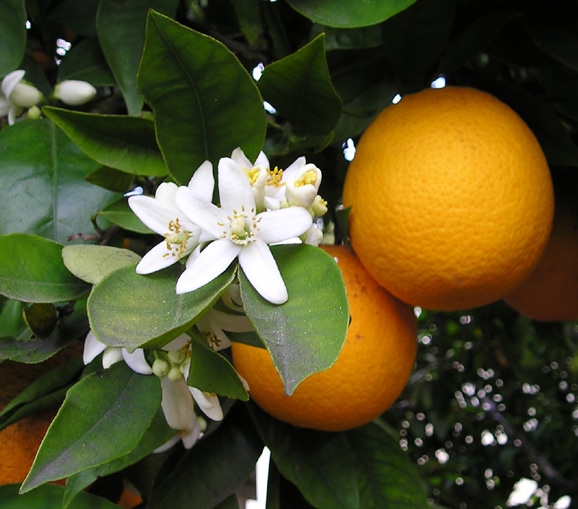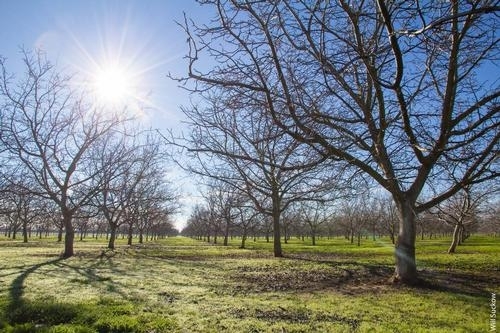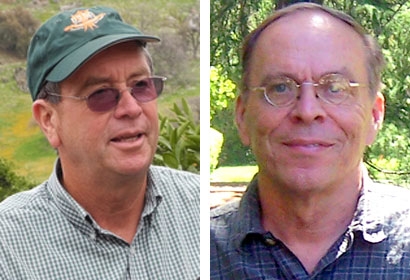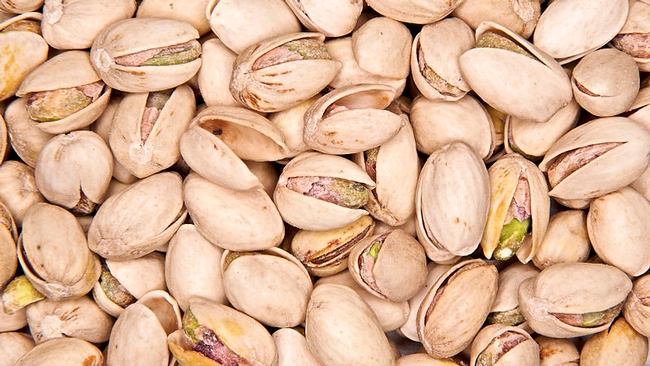Posts Tagged: Craig Kallsen
ANR in the news March 13-28
New Series of Nitrogen Management Advice Available
(Cal Ag Today) March 28
California growers can download a new series of publications summarizing efficient nitrogen management practices from UC Agriculture and Natural Resources. The publications are designed to assist growers in complying with state regulations for tracking and reporting nitrogen fertilizer applied to crops, in an effort to prevent nitrogen from leaching into groundwater.
https://californiaagtoday.com/new-series-of-nitrogen-management-advice-available
UC helps growers comply with new regulations
(Farm Press) Tim Hearden, March 27
A few months ago, while I was working with Todd Fitchette on a special package we were doing (or, he was doing and I was pitching in on) that focused on the 50th anniversary of the Citrus Research Board, I wrote a column about the benefits of land-grant universities such as the University of California (UC).
It's not an overstatement, I wrote, that the vast network of UC Cooperative Extension offices and research facilities has enabled agriculture in the Golden State to survive amid daunting challenges.
https://www.farmprogress.com/commentary/uc-helps-growers-comply-new-regulations
Communities come together to reforest Middletown Trailside Park
(Record Bee) Lucy Llewellyn Byard, March 27
Outdoorsman Greg Gusti, a University of California cooperative extension director emeritus who specializes in forests and wild lands ecology, addressed the crowd and gave them instructions on how to plant the trees 20 feet apart; showed them what 20 feet looked like on a tape measure, told them to plant the green side up and to keep the roots straight.
… Students dug in groups, sharing shovels and gloves. Sofie Hall and Elissa Holyoke worked with Michael Jones, a UC Cooperative Extension Forestry Advisor to plant their saplings.
The science and politics of genetically engineered salmon: 5 questions answered
(The Conversation) Alison Van Eenennaam, March 27
A Massachusetts-based company earlier this month cleared the last regulatory hurdle from the Food and Drug Administration to sell genetically engineered salmon in the U.S. Animal genomics expert Alison Van Eenennaam, who served on an advisory committee to the FDA to evaluate the AquAdvantage salmon, explains the significance of the FDA's move and why some have criticized its decision.
https://www.sfchronicle.com/news/article/The-science-and-politics-of-genetically-13719679.php
Students learn about insects at Farm Day in the City
(ABC 23) Amanda Mason, March 26
"Every single insect plays a role, even if it's only purpose is to get eaten by something. Everything is important," said Haviland.
David Haviland an entomologist at the University of California's Extension who studies insects and helps farmers manage agricultural pests, spent Tuesday at the Kern County Fairgrounds teaching students about good bugs and bad bugs at Farm Day in the City.
https://www.turnto23.com/homepage-showcase/students-learn-about-insects-at-farm-day-in-the-city
Expert: Speak up now about agriculture's carbon footprint
(Leader Telegram) Brooke Bechen, March 25
Dr. Frank Mitloehner, a professor and air quality extension specialist in the Department of Animal Science at the University of California-Davis, isn't afraid to speak up, particularly on Twitter where he writes under the handle @GHGGuru. He sees 2.5 million people visiting his Twitter account each month, which provides accurate information on air emissions and busts myths distributed by those looking to attack animal agriculture.
“Being in California is like being at Ground Zero,” he said. “There are urban centers of people who think they're food experts, but most of these people have never set foot on a farm and don't know anything about agriculture.
Wildfire Speaker Series Tonight: Fire Resistant Homes & Defensible Space
(YubaNet) March 25
…Dr. Kate Wilkin is the new Forest and Fire Adviser with UC Cooperative Extension in Butte, Nevada, Sutter, and Yuba Counties. She recently moved here from Berkeley, CA where she was postdoctoral researcher focused on wildfire emissions and fire-forest-water relations. Her PhD, also at UC Berkeley, focused on the efficacy of fuel treatments in Northern California shrublands to reduce fire hazards and on mixed conifer forest-fire-water and fire-biodiversity relations. Before moving to California, Kate grew up in rural Appalachia and then explored other fire-prone regions of the US as a natural resource manager and prescribed fire burner on public and nonprofit lands. Based on these experiences and more, she knows that we need to use solutions responsibly, both old and new, to solve our forest health crisis. Kate will be focusing on incorporating fire safe concepts into residential landscaping.
https://yubanet.com/regional/wildfire-speaker-series-tonight-fire-resistant-homes-defensible-space
UC Cooperative offers water-measurement class
(David Enterprise) March 25
California water rights holders are required by state law to measure and report the water they divert from surface streams. For people who wish to take the water measurements themselves, the University of California Cooperative Extension is offering training to receive certification April 4 in Redding and Woodland.
Costa Mesa designates April as Coyote Awareness Month and approves further informational efforts to manage them
(Los Angeles Times) Luke Money, March 20
…In the past 30 days, about 20 coyote sightings or encounters in Costa Mesa were logged with Coyote Cacher, an online reporting system [created by Niamh Quinn, UCCE advisor, and IGIS].
https://www.latimes.com/socal/daily-pilot/news/tn-dpt-me-cm-coyote-plan-20190320-story.html
UCCE Biologicals Conference Introduces New Crop Protection Tools for Growers
(Vegetables West) Matthew Malcolm, March 19, 2019
Biocontrol agents, beneficial microbes, entomopathogenic fungi and bacteria that can enhance crop production — these were all topics of discussion at the recent UC Cooperative Extension Ag Innovations Conference in Santa Maria, led by UCCE Entomology & Biologicals Advisor Surendra Dara. Watch this brief interview with Surendra as he shares more about what was discussed.
Landowners aim to fight fire with fire
(Benito Link) Blaire Strohn, March 19, 2019
The 2018 wildfire season in California was devastating, which left local landowners to consider how future blazes can be prevented. Their solution: more fire.
On March 14, The San Benito Working Landscapes Group and the UC Cooperative Extension (UCCE) hosted a meeting to discuss prescribed burning on San Benito County rangelands.
…UCCE livestock and natural resources advisor Devii Rao said the meeting also looked at Cal Fire funding and prescribed burn associations. She mentioned that last year former Gov. Jerry Brown signed two pieces of legislation related to prescribed burning:
Senate Bill 901 provides Cal Fire $1 billion for forest health, fuel load, and prescribed burns over five years, including $35 million a year for prescribed fire and other reduction projects.
Senate Bill 1260 requires Cal Fire to collaborate with public and private landowners on prescribed burns. They must also create a program for pre-certification for a “burn boss,” a private contractor that has experience in prescribed burning.
…In June, Rao will co-host a meeting with Lenya Quinn-Davidson and Jeff Stackhouse from UCCE Humboldt County. The meeting is expected to focus on how to develop a prescribed burn association, in addition to a small burn demonstration on a local private ranch.
https://benitolink.com/news/landowners-aim-fight-fire-fire
A More Humane Livestock Industry, Brought to You By Crispr
(Wired) Gregory Barber, March 19
Hopes were running high for cow 401, and cow 401 serenely bore the weight of expectations. She entered the cattle chute obligingly, and as the vet searched her uterus, making full use of the plastic glove that covered his arm up to his shoulder, she uttered nary a moo. A week ago, Cow 401 and four other members of her experimental herd at UC Davis were in the early stages of pregnancy. But now, following a string of disappointing checkups, it was all down to her. Alison Van Eenennaam, the animal geneticist in charge of the proceedings, kept watch from off to one side, galoshes firmly planted in the damp manure, eyes fixed on a portable ultrasound monitor. After a few moments, the vet delivered his fifth and final diagnosis. “She's not pregnant,” he said. Van Eenennaam looked up. “Ah, shit,” she muttered.
https://www.wired.com/story/crispr-gene-editing-humane-livestock
Climate change is hurting migrating waterbirds across the West. It could get worse
(Sacramento Bee) Andrew Sheeler, March 18
…Some birds, like the black-necked stilt and the sandhill crane, which breed early in the season, have thrived in the warming climate, said Mohammad Safeeq, a hydrologist with the Sierra Nevada Research Institute and an adjunct professor at UC Merced.
But others suffer. That includes the killdeer, the Wilson's snipe, the black tern, and the western and Clark's grebe.
“We have looked at 14 species and among eight open-water and shoreline foraging species that have undergone significant population declines, five were negatively associated with temperature increases,” Safeeq said in an email interview.
https://www.sacbee.com/news/local/environment/article227983859.html
Group seeks healthy, resilient forests and communities
(Plumas News) March 18
…A public workshop was held at the Quincy Library on Jan. 15th. Presenter Jeff Stackhouse, the Livestock and Natural Resources advisor for the U.C. Cooperative Extension in Humboldt, presents case studies from the prescribed burn association.
http://www.plumasnews.com/group-seeks-healthy-resilient-forests-and-communities
US researchers moving abroad to avoid FDA's CRISPR-edited animal regulations
(Genetic Literacy Project) Cameron English, Alison Van Eenennaam, March 14
One day soon, farmers may be able to raise food animals immune to deadly diseases and spare them painful but necessary procedures like horn removal. These innovations, made possible by CRISPR and other gene-editing techniques, could cut the cost of food production, reduce antibiotic use in agriculture and dramatically improve animal welfare. But federal regulation may very well stifle these developments in the US.
In 2017, the Food and Drug Administration (FDA) proposed a plan to regulate gene-edited animals as veterinary drugs under the 1938 Food, Drug and Cosmetic Act, because their DNA is “intentionally altered.” The proposal has drawn harsh criticism from animal scientists, some of whom are packing up their labs and leaving the US to avoid the FDA's rules. Food animals, these experts say, should be regulated based on the risk they pose to human health, not the breeding method that produced them.
Corky Anderson's energy, innovation helped save California's pistachio industry
(Bakersfield Californian) Steven E. Mayer, March 13
"Corky was an important player in the early pistachio industry," said a Kern County farm adviser with the UC Cooperative Extension who specializes in citrus and pistachios.
"And he was a great cooperator," Kallsen said. "He allowed lots of test trials on his properties."
… In 1980, Anderson and Puryear's first patented rootstock changed the industry, said Kevin Blackwell, general manager of Pioneer Nursery, the wholesale business founded by the two entrepreneurs.
"In our heyday, we were selling a million trees a year," said Blackwell, who said he has known Anderson for 47 years.
No one does it alone, Kallsen noted. Anderson built and refined his patented rootstock based on earlier research by the University of California.
Farmers protect crops in rain's aftermath
(Ag Alert) Ching Lee, March 13
Franz Niederholzer, University of California Cooperative Extension farm advisor in Colusa, Sutter and Yuba counties, said though cold weather does reduce the risk of most fungal diseases, other problems such as bacterial blast and jacket rot—also a fungal disease—are more prevalent during cool weather.
Cooler weather, however, does help to extend the bloom, he said. That allows farmers more time to apply fungicide, which is recommended at the beginning of bloom and again at full bloom, he said.
Brent Holtz, UCCE farm advisor in San Joaquin County, said he hasn't seen too many problems with fungal diseases at this point, because of how cool it's been, but there have been more incidents of bacterial blast, which can infect trees under stress. In orchards with high nematode populations, the bacteria can enter wounds on the surface of the plants created by frost, he noted.
"It blights the blossoms, and if the blossom is dead, they don't produce fruit," Holtz said.
http://agalert.com/story/?id=12801
Michael learns about 4-H in Fresno County
(KMPH) Stephen Hawkins, March 13, 2019
The 4-H Youth Development Program is preparing for events all over the Central Valley and you are invited.
Michael Ikahihifo spent the morning at Dry Creek Park in Clovis to see what the local 4-H has planned.
https://kmph.com/great-day/michael-in-the-mix/michael-learns-about-4-h-in-fresno-county
The City of Cypress calls for its residents to be “Coyote Aware”
(OC Breeze) March 13
The Cypress City Council recently adopted a coyote management plan to address community concerns about the presence of coyotes in Cypress. While coyotes are generally reclusive animals who avoid human contact, it is important to be aware of their presence and take appropriate action to ensure the safety of your property and pets.
…Residents are encouraged to reportcoyote activity on Coyote Cacher:
Coyote Cacher allows the City to monitor all reported encounters.
Residents can also use Coyote Cacher to view a map of reported
encounters and sign up to receive email alerts.
California's super bloom attracts swarms of migrating butterflies
(CNN) David Williams, March 13
This year's wildflower super bloom is not only filling California deserts with eye-popping displays of color -- it's also providing a feast for swarms of painted lady butterflies making their way north from Mexico.
"This is the biggest outbreak since 2005," said Art Shapiro, a professor at the University of California, Davis, who's been studying the migration of butterflies in the state since 1972.
…"I saw more butterflies in the last 10 minutes than I've seen my entire life," Jason Suppes wrote Tuesday on Twitter. Suppes is an education specialist at an agricultural research facility in Irvine.
http://edition.cnn.com/travel/article/california-butterflies-trnd/index.html
Grape growers continue push to mechanize
(Western Farm Press) Lee Allen, March 13
…In Fresno, growers affiliated with the San Joaquin Valley Winegrowers Association met to discuss the latest UC research on incidents of disease and machine injury to trunks and rootstock.
… “Growers are having a hard time finding workers to maintain their vineyards and increasing labor costs are challenging grape-farming's economic sustainability,” says UC Cooperative Extension viticulture advisor George Zhuang. “We're studying the use of machines to reduce the number of people needed to perform tasks like pruning.
“Because canopy architecture and yield characteristics involving mechanically-pruned vines are much different from those that are hand-pruned, water and fertilizer requirements for the mechanically pruned vines can be quite different. Performance of different rootstocks in mechanical pruning systems is critical for both yield and fruit quality of grape production in the San Joaquin Valley.”
…Kaan Kurtural, UC Cooperative Extension viticulture specialist in the UC Davis Viticulture and Enology Department, whose research involves improving vineyard production efficiency through canopy and crop load management via mechanization, says the case for switching out hand labor with machines gets stronger with growers using such mechanization for pruning, suckering, and removing shoots and leaves.
“Mechanical pruning can produce more stable year-to-year fruit yields of better quality than traditional and more costly hand pruning spurs or canes.” His comments were based on a Kern County two-year research trial looking for ways for growers to reduce both cost and water use.
https://www.farmprogress.com/grapes/grape-growers-continue-push-mechanize
As Wildfires Devour Communities, Toxic Threats Emerge
(Reuters) Sharon Bernstein, March 13
At U.C. Davis, where researchers are studying eggs from backyard chickens that may have breathed smoke and pecked at ash in areas affected by wildfires, the work is complicated.
"In an urban fire you're dealing with contaminants that don't go away – arsenic, heavy metals, copper, lead, transformer fluid, brake fluid, fire retardant," said veterinarian Maurice Pitesky, who is leading the study.
https://www.usnews.com/news/us/articles/2019-03-13/as-wildfires-devour-communities-toxic-threats-emerge
DR. GLENDA HUMISTON: Managing our Lands to Manage our Water
Maven's Notebook, March 13, 2019
Dr. Glenda Humiston is Vice President of Agriculture & Natural Resources for the University of California. At the 2019 California Irrigation Institute conference, Dr. Humiston was the opening keynote speaker, and in her speech, she talked about work being done to address drought vulnerability, the importance of managing watersheds, the goals of the California Economic Summit, and the promising future of biomass.
She began by saying that we have known for a long time that water insecurity is a huge issue, and not just due to climate change or droughts; it's also policy, regulations, allocations and technology – there are a lot of issues and managing the effects of it are very challenging.
https://mavensnotebook.com/2019/03/13/dr-glenda-humiston-managing-our-lands-to-manage-our-water/
Hearing planned to examine the future of development in California's most fire prone regions
(Lake County News) March 13
…The hearing, led by Senators Henry Stern and Mike McGuire, chair of the Senate Natural Resources and Water Committee and the Senate Governance and Finance Committee, respectively, titled “Living Resiliently in the New Abnormal: The Future of Development in California's Most Fire Prone Regions” will be held Wednesday at 9:30 a.m. at the State Capitol in Room 4203.
…Testifying at the hearing are:
· Mark Ghilarducci, director, California Office of Emergency Services;
· Bob Fenton, regional administrator, FEMA Region 9;
· Dr. Max Moritz, statewide wildfire specialist, University of California Cooperative Extension;
· Jeff Lambert, director of planning, city of Oxnard, past president, American Planning Association, California Chapter;
· Chief Kate Dargan, California State Fire Marshal (retired), Cal Fire;
· Chief Ken Pimlott, director (retired), Cal Fire;
· Scott Lotter, former mayor, city of Paradise;
· Tim Snellings, planning director, Butte County;
· Chief Michael McLaughlin, Cosumnes Community Services District Fire Department;
· Ty Bailey, California Professional Firefighters, president, Sacramento Area Firefighters, Local 522, fire captain, Sacramento Metropolitan Fire District.
Bakersfield stays dry during early October storm
Early this week, rain was in the forecast for Bakersfield, the southernmost city in the Great Central Valley, but UC Cooperative Extension farm advisors were unconcerned, reported John Cox in the Bakersfield Californian.
The rain never materialized, and that was good news for Craig Kallsen, UCCE Kern County citrus and pistachio advisor.
"In general, on the valley floor, if it's raining, somebody's going to get hurt," he said.
Kallsen said the ideal situation for farmers is when rain and snow fall on the mountains, providing water to be harnessed for irrigation. Because of the dry, warm climate in the South Valley, even after it rains, "It's probably going to dry out really rapidly."
UCCE orchard systems advisor Mohammad Yaghmour said rain is a bigger concern in the spring when almonds are in bloom. By this time of year, most almonds have been harvested, largely removing the threat of mold.
"For almonds, luckily, most of the harvest is almost over," he said. "I don't anticipate seeing much effect."
Climate change is impacting California tree crop farms
Rising temperatures appear to be reducing the number of hours tree crops in the San Joaquin Valley are subjected to chill during the winter, a critical factor in producing a profitable yield, reported Ezra David Romero on Valley Public Radio, KVPR-FM.
Pistachios, for example, require temperatures between 32 and 45 degrees for about 700 hours each winter, but for the past four years have had less than 500 chill hours.
UC Davis researcher Hyunok Lee recently published a study about climate change impacts on agriculture in UC Agriculture and Natural Resources' peer-reviewed journal California Agriculture. The study found that winter temperatures are increasing more than any other time of year. Her modeling looks at the year 2050 in Yolo County.
“Our agriculture will continue,” Lee said. “But if you look at . . . like 20 years or 30 years. The pattern may change a little bit, crops may move a little bit north.”
Romero spoke to UC Cooperative Extension farm advisor Craig Kallsen, who holds the UC Cooperative Extension Presidential Chair for Tree Nut Genetics. Kallsen is conducting trials aimed at finding pistachio varieties with novel nut, tree growth and yield characteristics, and varieties that produce a high yield even under low-chill conditions.
"We're trying to use the other species of pistachios actually to see if we can come up with something that has a low chill requirement. It's pretty hypothetical at this stage,” Kallsen told Romero. “We made quite a few crosses this spring and we actually hope to put a trial in a low chill area.”
David Doll, UC Cooperative Extension farm advisor in Merced County, is studying other tactics to improve winter chill, such as using overhead sprinklers to cool the trees and painting them white with liquid clay to reflect sunlight.
"So this is something that could impact a lot of farmers over the next 10, 20, 30 to 40 years,” Doll said. “And in fact it's already impacting farmers on random given years across the state."
UC ANR announces recipients of first two $1 million endowed chairs
The UCCE citrus and pistachio crops advisor in Kern County, Craig Kallsen, is the UC Cooperative Extension Presidential Chair for Tree Nut Genetics, and UCCE integrated orchard management specialist Bruce Lampinen, based at UC Davis, is the UC Cooperative Extension Presidential Chair for Tree Nut Soil Science and Plant Water Relations. The endowed chairs will give the two scientists a dedicated source of funding for five years, when the chairs are reopened for review.
UC ANR established the two $1 million endowments for the endowed chairs last year. Half the funding was provided by UC President Janet Napolitano; the other half was donated by the California Pistachio Research Board. Establishment of the endowed chairs was announced last year by UC ANR vice president Glenda Humiston.
“I'm pleased that we have identified two exceptional research programs to support with the first endowed chairs in the more than 100-year history of UC Cooperative Extension,” Humiston said. “I feel certain Craig and Bruce will make significant advances in pistachio production systems under California conditions.”
Pistachio breeding program
Kallsen said the endowment comes at a particularly opportune time for the UC pistachio breeding research program. In cooperation with UC Davis pomology researcher Dan Parfitt, Kallsen has been breeding pistachios as part of a variety selection program using conventional methods - manually crossing and then growing trees to determine whether they have beneficial characteristics.
“Breeding new varieties this way takes a while, especially in pistachios,” Kallsen said. “They don't bloom for four or five years. With some trials we are just now at the stage where it gets interesting. The funding will be helpful for evaluating the new progeny.”
Kallsen is looking for pistachio varieties that show novel nut, tree growth and yield characteristics, and for varieties that produce a high yield even under low-chill conditions.
“The climate appears to be warming,” Kallsen said. “That poses a problem for pistachios, because our current cultivars have a significant chilling requirement that has not always been met when we don't have cold, foggy winters.”
Kallsen plans to establish a trial pistachio orchard at the UC Riverside Coachella Valley Agricultural Research Station, where winter weather rarely dips to sufficient chill levels, to see which varieties produce acceptable crops under the warmer conditions.
Another key objective of the UC breeding program is identifying pistachio cultivars that mature at different times. At the moment, 90 percent of California pistachios are the Kerman variety. They all mature at the same time, putting pressure on harvesting, transportation, processing and storage resources.
“Ten years ago, UC introduced the Golden Hills variety, which matures about two weeks earlier. It now represents 5 or 10 percent of the state's crop,” Kallsen said. “We're looking closely at another potential cultivar that matures 10 days before Golden Hills.”
Pistachio research at UC Davis
Lampinen has devoted most of his career to almond and walnut research, but has worked on pistachios in collaboration with other UCCE specialists and advisors since 2009, focusing mainly on canopy light interception and salinity and their impacts on pistachio yield and water use.
Lampinen said his current work on almond and walnut water use as related to canopy size will be expanded to pistachio with the funding from the endowment.
“Some preliminary data on this is currently being gathered, but there is a need to expand this work to a wider range of orchard ages and planting configurations,” Lampinen said. “It will be very useful to have the ongoing support from an endowment.”
Lampinen's work in almonds and walnuts will also inform new pistachio research approaches. For example, Lampinen developed a no-pruning system for establishing new walnut orchards, and will study whether a similar approach in pistachio would make sense. For decades, California farmers believed that pruning young walnut trees was critical to healthy tree development. Lampinen observed unpruned walnut orchards in France, and “they looked perfectly fine,” he said.
Lampinen's research showed that pruning in the early years of tree development reduced water use efficiency and decreased walnut yields. By not pruning young trees, farmers could cut back significantly on labor costs and eliminate the need to dispose of the vegetation cut off the tree while using water more efficiently.
The no-pruning approach is now widely accepted in almonds and walnuts. With funding from the five-year endowment, he plans to compare the impacts of the alternative pruning systems on newly established pistachio orchards.
In addition, Lampinen said he plans to consult with pistachio industry leaders, growers and farm advisors to develop an effective research program on pistachio soil and water relations.
Too many California pistachios coming up empty
Some California pistachio farmers are facing one of their worst harvests ever, reported Sarah Zhang on Wired.com.
UC Agriculture and Natural Resources experts said the dip in yield cannot be blamed on the drought, but a warming climate may be coming into play. Pistachios require cold winter temperatures to reset their biological clocks.
“They use the temperature to know when winter is over,” said Craig Kallsen, UC Cooperative Extension advisor in Kern County. “And if they don't get the message, they get confused.”
Male trees then end up blooming after the female tree. If female plants don't get fertilized when they bloom, they still produce shells—just empty ones.
Kallsen said the hardest hit regions are in the Southern San Joaquin Valley.
"We're looking at a record low (yield)," Kallsen said.
Farmers to the north had more chilling hours, so they are seeing a normal or low number of empty pistachio shells.
Growers have found that spraying oil can help trees bloom more uniformly, however, it doesn't always seem to help, the story said.
“There are a lot of things we're still trying to understand,” said Gurreet Brar, UC Cooperative Extension advisor in Fresno County. “Oil applied at the wrong time or in inappropriate conditions like water stress conditions can injure the plant.”

